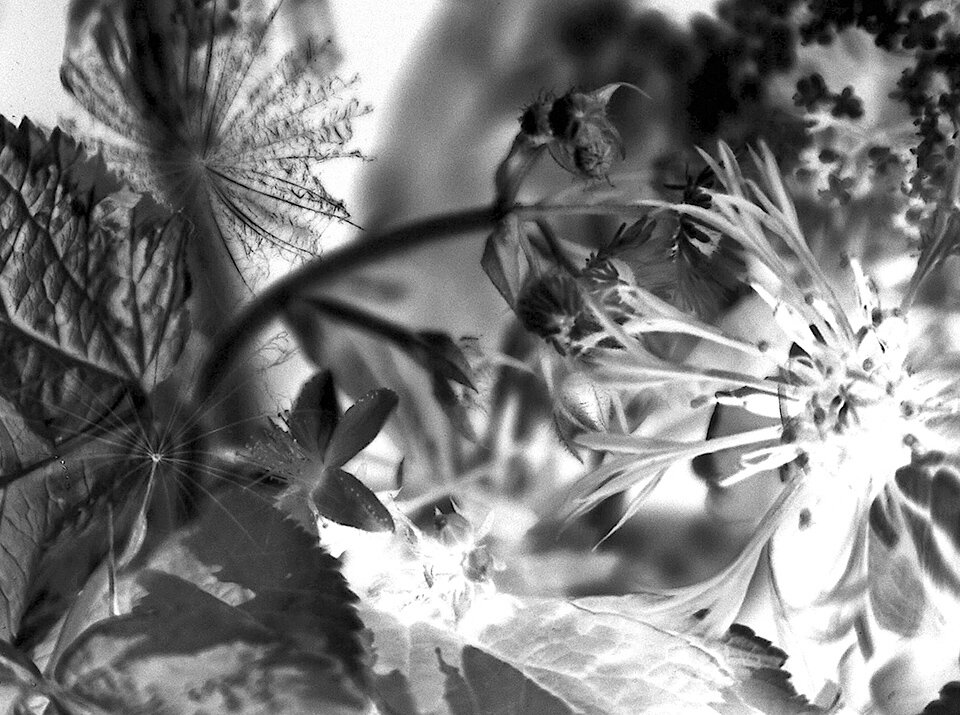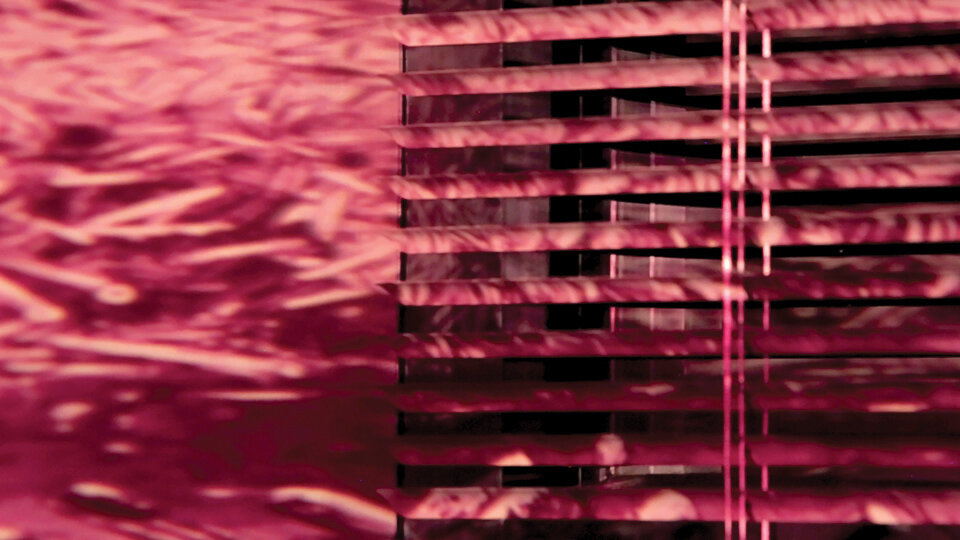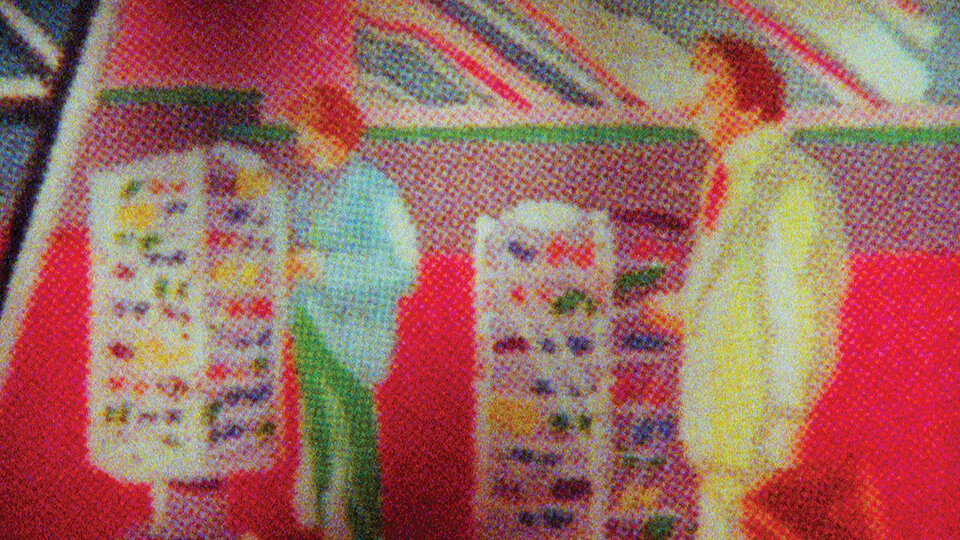Antimatter 2018
Media Installations
October 11 to 21, 2018





in the main Deluge gallery
Framing Nature
Kyath Battie | Ramey Newell | Elina Oikari | Kalpana Subramanian | Emilio Vavarella
“Animism makes real the permeability of human and nonhuman worlds. As a structure of perception and framework of experience, the relevance of animism to the theme of cinema beyond the human lies in its conception of the self as porous with respect to a multiplicity of life forms.” – Screening Nature: Cinema beyond the Human, Anat Pick & Guinevere Narraway
Framing Nature is a group exhibition that gives voice to ecological thought, uncentering human language in favour of the non-human, the other. Nature here is resistant to definition through anthropomorphic language, insisting on an interconnectivity and creative function far beyond the shadow cast by man’s colonizing and taxonomical tendencies. These five works subvert and dismantle existing historical depictions of the environment through a multiplicity of approaches which challenge our limited temporal understanding—refracting and expanding our comprehension of the past into a future comprising worlds within worlds, not all of our making and beyond our control.
Senescent Vivarium | Kyath Battie | 2018 | 7 min
Bordering on the fantastic, Senescent Vivarium represents four distinct seasons created by plants and insects selected to imitate authentic biospheres. These macro worlds are architectural masters of their own domain yet defy traditional still life representations. Transient narratives of familiar ecological cycles are pushed further into supernatural territory by the effects of hand processed 16mm black and white film and a deeply atmospheric, magnetic sound score.
Kyath Battie is a filmmaker and experimental media artist, with specific interests in mysteries, landscapes and sound design. Her work ranges from personal and observational documentaries to atmospheric spatial explorations of space. Battie’s work also involves large-scale viewership, often creating a fine line between a “cinematic” and still photographic experience. She teaches in the Department of Cinema at Denison University, in Ohio, USA.
Insecta | Ramey Newell | 2017 | 5 min
Archival video and narration, combined with original laboratory photography and intricate sound compositions, examine our collective relationship with the nonhuman world. Implicating histories of both scientism and documentary filmmaking, this short experimental film constructs an increasingly unsettling portrait of human callousness in our compulsive quests for knowledge and control of the “natural” world.
Ramey Newell is an interdisciplinary artist and filmmaker whose work explores issues relating to ecology and mass extinction, scientific epistemologies, anthropocentrism and the expectations of documentary film. Her moving image work has screened in festivals, galleries and museums throughout the United States, the United Kingdom, Canada and Australia. She holds a BFA in Photography, a graduate certificate in Documentary Media and is currently based in Vancouver, Canada while completing her MFA in Visual Art at UBC.
Govadas | Elina Oikari | 2018 | 9 min
Govadas explores the contradiction and harmony between humans and nature through Sámi poetry. The cyclical perception of time among the only indigenous people living in the European Union is presented in the work as unfolding forms and layers based on archival material from the 1940s and Super 8 footage from 2010s. Govadas creates a kinetic meditation on time, memory, landscape and the ruptures between them.
In Govadas, Elina Oikari creates a cinematic portrait of Sámi people from history to our times and explore their relation with nature as Nils-Aslak Valkeapää has described. In Valkeapää’s work, traditional Sámi culture is presented as nomadic, holistic, non-violent and in harmony with nature, while Western culture is presented as intrusive, violent, arrogant and polluting.
Oikari’s approach to the subject starts from Valkeapää’s poem, where he describes “image” as a concept of an auto-portrait that is being seen from outside and inside. This poem inspired the director to create a cinematographic essay about the possible images that Valkeapää could have received during his writing process. Valkeapää’s poetry is very visual and he has even created some new words to describe the word “image.” Also the structure of Govadas is close to a poem, as the filmmaker intended to create an experience for the viewer to let him or her to find out the core meaning of the film.
Elina Oikari is a filmmaker and media artist based in Helsinki. She received her MA from the Aalto University Documentary Film Studies in 2014. Oikari emphasizes experimental connections between image and sound in her works which have also screened as film concerts and live cinema screenings at various film festivals and music events. Her work is often related to the classics of dramatic literature and experiences of otherness.
A Dialogue of Dissonance | Kalpana Subramanian | 2016 | 7 min
An aesthetic meditation on the technological incompatibilities of cinematic apparatus that engages the poetics of materiality. Light and projections mediated by a 16mm projector playing a aging strip of stock film are captured by a state-of-the-art video camera at various speeds and settings. Visual “disruptions” occur as these disparate media engage with each other, creating a “dialogue of dissonance,” blurring lines between the digital and analogic and between the pro-filmic and filmic.
In my view, light is like the “breath” of cinema’s body. In this film I explore the intervals and inbetweenness of cinematic form, in dialogues between “old” and “new” media. The differences in frame-rates of digital and analog media lead to a cinematic event that is both created with and captured by my camera. A play of intermittencies emerging from the techno-dialogue of digital and analogic media led to a sensorial experience for me as a cinematographer, and later as an editor when I attempted to articulate this. The process of filming became an act of contemplation on difference and the aesthetics of dissonance. This film was shot in a day, in a single setting, as part of a series of five films titled Light Mediated: Eyes on Brakhage (2016).
Kalpana Subramanian is an artist, filmmaker and educator, currently pursuing a practice-based Ph.D. in Media Study at the State University of New York at Buffalo. She is interested in transcultural and interdisciplinary approaches of inquiry into the aesthetics of experimental film and media. Her research re-considers American avant-garde film history though the lens of non-Western philosophies. She was awarded a Fulbright Professional and Academic Excellence Fellow at the Stan Brakhage Center at the University of Boulder Colorado in 2015–2016. Her short films has been screened at several international festivals and received various awards. She is also the recipient of the UK Environmental Film Fellowship (2006) and the Audio International Design Award (1996).
Animal Cinema | Emilio Vavarella | 2017 | 12 min
Animal Cinema is a film composed of fragments of videos of animals operating cameras. All cameras were stolen by animals who acted autonomously. These video materials, downloaded from YouTube between 2012 and 2017, have been reorganized as a constant unfolding of non-human modes of being.
Animal Cinema is my first film. It stems from my art practice and it expands my investigation of non-anthropocentric audio-visual experiences. I believe that a new regime of moving images is emerging in the tension between ideas of sensorial contact, encounter and closeness, and the presence of the unthought, the unsummonable, the inexplicable and the undecidable.
Emilio Vavarella is an artist whose work blends interdisciplinary art practice and theoretical research and is centred around the study of the relationship between humans and technological power. Currently working toward a PhD in Film and Visual Studies and Critical Media Practice at Harvard University, his artworks have been exhibited at many of the most prestigious festivals of media arts and in foundations and museums around the world, including Rome’s MAXXI – Museo Nazionale delle arti del XXI Secolo, Bologna’s Museo d’Arte Moderna, Santiago’s Museo Nacional Bellas Artes and Tokyo’s National Art Center. His work has been discussed in Artforum and Neural, in books such as The New Aesthetic and Art, and it regularly appears in the popular press and in peer-reviewed journals.
in the Deluge transom window
Flying to Nowhere
Matthew Lancit | 2017 | 1 min
A kinetic study in discipline and hope: what is the measure of success?
Matthew Lancit is an award-winning Canadian filmmaker based in Paris, France. His work varies between experimental, narrative, documentary, ethnographic and video dance. His films have screened at Museum of the Moving Image, UnionDocs, cutlog gallery, Anthology Film Archives in New York, the Kaohsiung Film Archive in Taiwan, the Musée Dapper in Paris and the Jerusalem Cinematheque. After moving to Cameroon, Lancit made his first feature length documentary, Funeral Season—which has since been chosen for preservation by the Library and Archives of Canada and selected by more than 50 festivals internationally.
at Ministry of Casual Living Window Gallery
Sculpt the Motion
Devis Venturelli | 2017 | 6 min
Sculpt the Motion shows continuous transformations of metallic bodies through different urban plans. Contemporary architecture is a scenario for performance, an experience as a sculptural promenade in continuous flux. Silver strata of insulating material in action via the body become mobile sculpture evoking Boccioni’s Futurist dynamism. This film echoes back to the textile kinematics of Serpentine Dance, recalling a mobile texture and a continuous metamorphosis of shapes. The body becomes a ritualistic/gestural expression, partly from an interest in the depiction of the body as malleable material. Gilles Deleuze’s famous remark that the body is “but a series of images” remembered, desired, rejected and dreamt, is an apt description of its place within the piece.
A multi-disciplinary artist based in Milan, Devis Venturelli deftly employs the languages of video, performance, sculpture and installation to document ephemeral architectures and temporary utopias. He has participated in many solo and group shows in museums, institutions and galleries throughout the world, including the Lincoln Center for the Performing Arts, Anthology Film Archive, PAC, Milano, Ace Gallery, Kunsthalle, Wien and la Biennale di Venezia.
at Legacy Art Gallery
Breathing
Taryn Kneteman | 2016 | 8 min
Breathing is an improvisational moment in the suspended time before a storm. Filmed between the conjuring and arrival of heavy-bellied clouds, the dropping pressure invites energy to flow freely and the possibility of detecting something previously unnoticed arises.
Time stretches—something is put up to huddle under. A suspended plastic tarp is a tenuous shelter: too close and its surface impedes respiration, too far and contact is lost. The bottom edge becomes loose. Partially freed from its four-cornered restraint, the draped surface flickers in the diffuse light. The spectral movement and crackle of creases, folds, concavities and edges index latent wind, in what had seemed like empty space.
Based in Edmonton, Taryn Kneteman uses video, photography and sculpture to create situations where the valence of certainty is thin, to challenge complacencies of seeing and invite curiosity in perception. Kneteman received her BFA from the University of Alberta and has exhibited and participated in residencies in Canada, the United States, Germany and China.
at FLUX Media Gallery
Resonant Disintegration
Colton Hash | 2018
Resonant Disintegration is an interactive multimedia installation that presents an immersive space for viewers to reflect on their relationships to oceanic life in the context of climate change. A life-size form of an adolescent female orca is suspended at eye level in the space, inviting viewers to approach and physically engage with the sculpture. The metal whale is corroded from having been immersed in the Salish Sea, a performative gesture which connects the material to this specific body of water. The sculpture is a representation of “J-53,” the youngest living female southern resident killer whale of J-Pod. The installation fosters a sobering emotional space that is both beautiful and haunting, where viewers can be present with complex feelings of mourning and admiration.
As a tree planter in Northern British Columbia, Colton Hash has been exposed to mass industrialization from forestry and petroleum development. Now living in close proximity to the Salish Sea, he has become increasingly influenced by factors affecting ocean ecosystems and the critical importance of marine life to coastal communities. These observations have informed his practice as both an artist and social justice organizer. Hash has collaboratively performed in social events and has exhibited emotionally engaging artworks in community-oriented spaces.
at FLUX Media Gallery
Gone Sale
Matt Meindl | 2018 | 5 min
Faceless forms inhabit the shadow-sprayed remnants of an electronic board game. Slumber party capitalism, now a bargain bin of lost dreams.
Matt Meindl is a filmmaker and musician whose work reveals strange new views of familiar surroundings. His work often explores fickle fantasy, isolation and the fine line between precious and obsolete. Meindl’s films and videos have screened at festivals and art spaces throughout North America including the Ann Arbor Film Festival, Chicago Underground Film Festival, WNDX, Rural Route @Anthology Film Archives, OFF THE WALL and the Milwaukee Underground Film Festival. He is the recipient of media arts grants from the Ohio Arts Council and Greater Columbus Arts Council, and is a former Wexner Center video artist-in-residence. Meindl lives in Los Angeles and is currently working on new films and a recording project (as Hoodie Guthrie).
at FLUX Media Gallery
The Fullness of Emptiness
Sam Scoggins | 2018 | 5 min
Hundreds of still photographs from copyright-free archives were assembled into a digital sequence of one still per frame, cropped to the same size and aspect ratio. At 24 frames per second the sequence insists on the sovereignty of the individual frame and rejects the illusion of movement. Each image eradicates the last. Some images seem consciously visible to the viewer, whilst others are apparently never seen.
The soundtrack—“The Heart Sutra” by Baird Hersley and his group Prana—uses overtone vocal harmonics to recite the mantra, Gate Gate Paragate Parasamgate Bodhi Svaha.
The film is thus both a meditation on the nature of perception and an expression of the power of emptiness. As Thich Nhat Hanh explains in his essay “The Fullness Of Emptiness” (Lion’s Roar, Aug 6, 2012): “When Avalokita says that our sheet of paper is empty, he means that it is empty of a separate, independent existence. It cannot just be by itself. It has to inter-be with the sunshine, the cloud, the forest, the logger, the mind and everything else. It is empty of a separate self. But, empty of a separate self means full of everything.”





